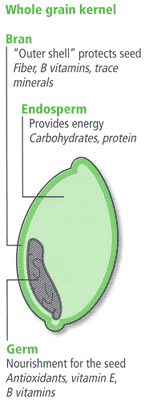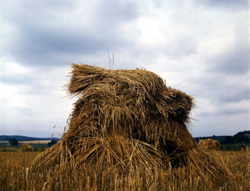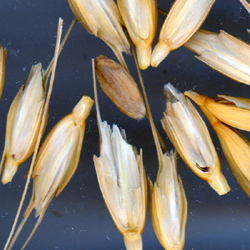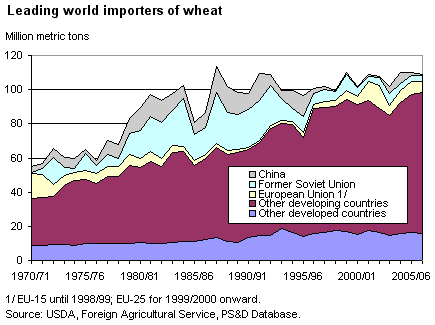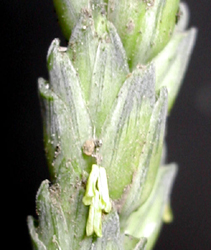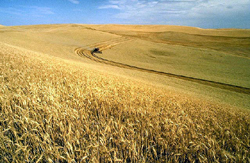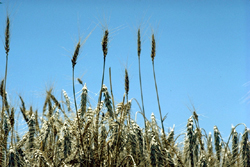Wheat/Citable Version
| Wheat | ||||||||||||
|---|---|---|---|---|---|---|---|---|---|---|---|---|
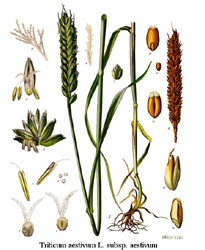 | ||||||||||||
| Scientific classification | ||||||||||||
| ||||||||||||
| Species | ||||||||||||
|
T. aestivum |
Wheat (Triticum spp.)[1] is a grass that has so many important uses that it is cultivated worldwide. Its suitability for large-scale cultivation and provision of stored food enabled the emergence of city based societies at the start of civilization. Globally, it is one of the three most popular human food grain crops, ranking second in total production as a cereal crop behind maize (corn), and ahead of rice.[2] Wheat grain is a staple food used to make flour for leavened, flat and steamed breads, cookies, cakes, pasta, noodles and couscous;[3] and for fermentation to make beer,[4] many different alcoholic spirits including grain whisky and vodka or biofuel[5][6]. The husk of the grain, separated when milling white flour, is bran. Wheat germ is the embryo portion of the wheat kernel. It is a concentrated source of vitamins, minerals, and protein, and is sustained by the larger, starch storage region of the kernel - the endosperm.
Some wheat is planted as a forage crop for livestock, and the straw can either be used as bedding for livestock or as a construction material for roofing thatch. In England, thatch was used for roofing in the bronze age, and was in common use until the late 19th century [1].
History
- See also Crop origins and evolution
Wheat is the one of first cereals known to have been domesticated. The general archeological record has long suggested that this initially occurred in the regions known as the Fertile Crescent, and the Nile Delta. These include southeatern parts of Turkey, Syria, the Levant, Israel, and Egypt. Recent findings narrow the first domestication of wheat down to a small region of southeastern Turkey.[7]
Karacadag Mountains, Turkey, 8,800 BCE
Genetic analysis of wild einkorn (diploid) wheats indicate that this wheat was first domesticated in the Karacadag Mountains in southeastern Turkey. Archeological remains of eincorn wheat in settlement sites near this region, including Cafer Höyük, Cayönü, Nevali Cori and Abu Hureyra provided confirmation for the domestication of einkorn near the Karacadag Mountain Range. The earliest carbon-14 date for these eincorn remains at Abu Hureyra is 7800 to 7500 before the current era (BCE). [8] Recent genetic and archeological discoveries indicate that the tetraploid wheats emmer and durum (hard wheat ) originated from this same region of southeastern Turkey. Early remains of harvested emmer from several sites near the Karacadag Range have been dated to between 8,800 BCE and 8,400 BCE during the Neolithic period. [9]
Cultivation and repeated harvesting and sowing of the grains of wild grasses led to the selection of mutant forms of wheat with various changes to the ear structure and fragility. In domesticated wheat grains are larger and seeds remain attached to the ear during the harvest process, rather than the ear shattering and spreading the seed.[10] Selection for such traits by farmers was an important part of crop domestication. As the very traits that improve wheat as a food source also involve the loss of the plant's natural seed dispersal mechanisms, highly domesticated strains of wheat cannot survive in the wild.[11]
Cultivation of wheat began to spread beyond the Fertile Crescent after about 8,000 BCE. Jared Diamond traces the spread of cultivated emmer wheat starting in the Fertile Crescent about 8500 BCE, reaching Greece by 6500 BCE and Germany by 5000 BCE [12]. "The early Egyptians were developers of bread and the use of the oven and developed baking into one of the first large-scale food production industries. " [13] By 5,000 BCE, wheat had reached Ethiopia, India, Ireland and Spain. A millennium later it reached China.[11] Technological advances in soil preparation and seed placement at planting time, use of crop rotation and fertilizers to improve plant growth, and advances in harvesting methods have all combined to promote wheat as a viable crop. Agricultural cultivation using horse collar leveraged plows (3000 years BCE) was one of the first innovations that increased cereal grain farm productivity. Much later, when the use of seed drills replaced broadcasting sowing of seed in the 18th century, another great increase occurred. Yields of wheat continued to increase, as new land came under cultivation, methods of crop rotation were applied to long cultivated land, and the use of fertilizers became widespread. Improved agricultural husbandry has more recently included threshing machines and reaping machines (the 'combine harvester'), tractor-drawn cultivators and planters, and better varieties (see green revolution and Norin 10 wheat). Several factors are moderating pressures for global growth in wheat production: population growth rates are falling while wheat yields continue to rise; heavier investment in modern genetic technologies with other crops such as soybeans and maize, linked with better profitability has promoted farmer shifts to other crops. Global production tonnages for wheat were overtaken by both rice and maize by 1999. [14]
Species of wheat
Many taxonomic classification systems are used for wheat species, discussed in a separate article on Wheat taxonomy. It is good to keep in mind that the same wheat species might be called by different names in sources written by different authors.
Template:Details Major cultivated species of wheat
Tetraploid wheats are hybrid species that arise by cross fertilizations between two different wild grasses. Their chromosome content is represented as AABB to indicate the sets of chromosomes they contain, A and B being the component genomes:
- Durum - (T. durum) The only tetraploid form of wheat widely used today, and the second most widely cultivated wheat
- Einkorn - (T. monococcum) A diploid species with wild and cultivated variants. One of the earliest to be cultivated, but rarely planted today. It has similar parental diploids wheat origin to durum.
- Emmer - (T. dicoccon) A tetraploid species, cultivated in ancient times but no longer in common use.
- Kamut® or QK-77 - (T. polonicum or T. durum) A trademarked tetraploid cultivar grown in small quantities that is extensively marketed. Originally from the Middle East
Hexaploid wheats arise by hybridisation between a teretraploid wheat and a diploid native grass (DD). Chromosome formula AABBDD or similar:
- Common Wheat or Bread wheat - (T. aestivum) A hexaploid (six chromosome sets, AABBDD) ) species that is the most widely cultivated wheat, orininally arising in antiquity from a durum wheat which crossed with a diploid native grass near the Caspian sea.
- Spelt - (T. spelta) Another hexaploid species cultivated in limited quantities.
- Synthetic hexaploid wheat - Recently created hexaploid wheats AABBDD now reaching the market, deliberately bred from wild grass tetraploids and diploids with the aim of increasing stress resistance and genetic diversity in cultivated wheats.
Within a species, wheat cultivars are further classified by (1) growing season, such as winter wheat vs spring wheat[15], by (2) gluten content, such as hard wheat (high protein content) vs soft wheat (high starch content), or by (3) grain color (red, white or amber).
Hulled versus free-threshing wheat
Four wild species of wheat, and the domesticated einkorn[16], emmer[17] and spelt[18] wheats, are hulled (in German, Spelzweizen). The more primitive morphology of hulled wheat consists of toughened glumes that tightly enclose the grains, and (in domesticated wheats) a semi-brittle rachis that breaks easily on threshing. As a result, when threshed, this sort of wheat ear breaks up into spikelets. To obtain the grain, further processing, such as milling or pounding, is needed to remove the hulls or husks. By contrast, in free-threshing (or naked) forms of wheat, such as durum wheat and common wheat, the glumes are fragile and the rachis tough. On threshing, the chaff breaks up, releasing the grains. Hulled wheats are often stored as spikelets because the toughened glumes give good protection against pests.[16]
Economics
Harvested wheat grain is classified according to grain properties for the commodities market. Wheat buyers use these classifications when deciding which wheat to buy, as each class has special uses, and producers use them to decide which classes of wheat will be most profitable to cultivate.
Wheat is widely cultivated as a cash crop because it produces a good yield per unit area, grows well in a temperate climate even with a moderately short growing season, and yields a versatile, high-quality flour that is widely used in baking. Most breads are made with wheat flour, including many breads named for the other grains they contain - like most rye and oat breads. Many other popular foods are made from wheat flour as well, resulting in a large demand for the grain even in economies with a significant food surplus.
Low international wheat prices in recent years have often encouraged farmers in the USA to change to more profitable crops. In 1998, the price at harvest was $2.68 per bushel. A USDA report[19] revealed average operating costs of $1.43 per bushel and total costs of $3.97 per bushel. In that study, farm wheat yields averaged 41.7 bushels per acre, and typical total wheat production value was $31,900 per farm, with total farm production value (including other crops) of $173,681 per farm, plus $17,402 in government payments. There were significant profitability differences between low- and high-cost farms. These profitability differences were mainly due to crop yield differences, location, and farm size.
In 1997, global wheat consumption was 101 kg per capita, with the highest consumption (623 kg per capita) found in Denmark, but most of this (81%) was for animal feed.[20] Wheat is the primary food staple in North Africa and the Middle East, and is growing in popularity in Asia.
See also International wheat production statistics.
| Top Ten Wheat Producers - 2005 (million metric ton) | |
| China | 96 |
| India | 72 |
| USA | 57 |
| Russia | 46 |
| France | 37 |
| Canada | 26 |
| Australia | 24 |
| Germany | 24 |
| Pakistan | 22 |
| Turkey | 21 |
| World total | 626 |
| Source: UN Food & Agriculture Organisation (FAO) | |
Agronomy
Crop development
Wheat normally needs between 110 and 130 days between planting and harvest, depending upon climate, seed type, and soil conditions (winter wheat lies dormant during a winter freeze). Optimal crop management requires that the farmer have a detailed understanding of each stage of development in the growing plants. In particular, spring fertilizers, herbicides, fungicides, growth regulators are typically applied only at specific stages of plant development. For example, currently, it is recommended that the second application of nitrogen is best done when the ear (not visible at this stage) is about 1 cm in size (Z31 on Zadoks scale). Knowledge of stages is also important to identify periods of higher risk from the climate. For example, pollen formation from the mother cell, and the stages betweed anthesis and maturity are susceptible to high temperatures, and this adverse effect is made worse by water stress. [21][22] Farmers also benefit from knowing when the 'flag leaf' (last leaf) appears, as this leaf represents about 75% of photosynthesis reactions during the grain filling period, and so should be preserved from disease or insect attacks to ensure a good yield.
Several systems exist to identify crop stages, with the Feekes and Zadoks scales being the most widely used. Each scale is a standard system which describes successive stages reached by the crop during the agricultural season.
Wheat stages
- Wheat at the anthesis stage (face and side view)
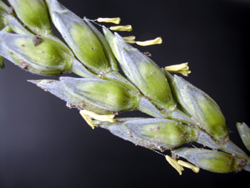
|
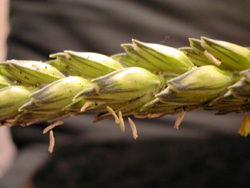
|
Diseases
There are many wheat diseases, mainly caused by fungi, bacteria and viruses.[23] Plant breeding to develop new disease-resistant varieties, and sound crop management practices are important for preventing disease. Fungicides, used to prevent the significant crop losses from fungal disease, can be a significant variable cost in wheat production.
The main wheat-disease categories are:
- Seed-Borne Diseases: these include seed-borne scab, seed-borne Stagonospora (previously known as Septoria), common bunt (stinking smut), and loose smut. These are managed with fungicides.
- Leaf- and Head- Blight Diseases: Powdery mildew, leaf rust, Septoria tritici leaf blotch, Stagonospora (Septoria) nodorum leaf and glume blotch, and Fusarium head scab.
- Crown and Root Rot Diseases: Two of the more important of these are 'take-all' and Cephalosporium stripe. Both of these diseases are soilborne.
- Virus Diseases: Wheat spindle streak mosaic (yellow mosaic) and barley yellow dwarf are the two most common virus diseases. Control can be achieved by using resistant varieties.
Main article: Wheat diseases
Pests
Wheat is eaten by the larvae of some Lepidoptera species including The Flame, Rustic Shoulder-knot, Setaceous Hebrew Character and Turnip Moth. Early in the season, birds and rodents can also cause significant damage to a crop by digging up and eating newly planted seeds or young plants. They can also damage the crop late in the season by eating the grain from the mature spike. Rodents can also cause major losses during storage, and in major grain growing regions, field mice numbers can sometimes build up explosively to plague proportions because of the ready availability of food.
Farming systems
In the Punjab, India, and North China, irrigation has been a major contributer to increased grain output. More widely over the last 40 years, a massive increase in fertilizer use together with the increased availability of semi-dwarf varieties in developing countries, has greatly increased yields per hectare. In developing countries, gross (mainly nitrogenous) fertilizer use increased 25-fold in this period.
Farming systems rely on much more that fertilizer and breeding for productivity improvement. A good illustration of this is Australian wheat growing in the southern winter cropping zone, where, despite low rainfall (300 mm) wheat cropping is successful using relatively low inputs of nitrogenous fertilizer. This is achieved by rotation cropping (traditionally called the ley system) with leguminous pastures and, in the last decade, including a canola crop in the rotations to achieve a further 25% boost in wheat yields [24]. In these low rainfall areas, better use of available soil-water (plus control of soil erosion) is acheived by retention of stubble after harvesting and minimized use of tillage. [25]
Genetics and breeding
- See also Plant breeding
Wheat genetics is more complicated than that of most other domesticated species. Some wheat species occur as stable polyploids, having more than two sets (the diploid number) of chromosomes.[26]. A single set of wheat chromosomes contains a huge number of DNA base pairs - 16 billion, 40 times as much as rice, and five times as much as humans.
- Tetraploid wheats have two sets of paired chromosomes, twice the number of chromosomes as a diploid wheat. Most tetraploid wheats (e.g. emmer and durum wheat) are derived from wild emmer, T. dicoccoides. Wild emmer is the result of a hybridization between two diploid wild grasses, T. urartu and a wild goatgrass such as Aegilops searsii or Aegilops speltoides. The hybridization that formed wild emmer occurred long before domestication, and was driven by natural selection.[26]
- Hexaploid wheats evolved in farmers' fields. Either emmer or durum wheat hybridized with yet another wild diploid grass (Aegilops tauschii) to make the hexaploid (six chromosomes) wheats, spelt wheat and bread wheat.[26]These wheats have three sets of paired chromosomes, three times the number of chromosomes in diploid wheat.
Presence of certain versions of particular wheat genes has been important in raising crop yields. Besides the mutant versions of genes that were selected in antiquity during domestication, there has also been more recent deliberate selection of alleles that further change the growth characteristics of the plant. Genes for the 'dwarfing' trait, first used by Japanese wheat breeders to produce short stalked wheat, have had a huge effect on wheat yields world-wide and were major factors in the success of the Green revolution in Mexico and Asia. Dwarfing genes enable more efficient diversion of carbon fixed in the plant during photosynthesis towards seed production, and help prevent the problem of lodging. 'Lodging' occurs when a ear stalk falls over in the wind and rots on the ground, and heavy nitogenous fertilization of wheat makes the grass grow taller and become more susceptible to this problem. By 1997, 81% of the developing world's wheat acreage was planted to semidwarf wheats, giving both increased yields and better response to nitrogenous fertilizer.
Wild grasses in the genus Triticum and related genera, and grasses such as rye have been a source of many disease resistance traits for cultivated wheat breeding since the 1930s.[27]
Heterosis, or hybrid vigor (as in the familiar F1 hybrids of maize), occurs in common (hexaploid) wheat, but it is difficult to produce seed of hybrid cultivars on a commercial scale (as is done with maize) because wheat flowers are complete and normally self-pollinate.[28] Commercial hybrid wheat seed has been produced using chemical hybridizing agents; these chemicals selectively interfere with pollen development, or naturally occurring cytoplasmic male sterility systems. Hybrid wheat has been a limited commercial success in Europe (particularly France), the USA and South Africa.[29] F1 hybrid wheat cultivars should not be confused with standard method of breeding inbred wheat cultivars by crossing two lines using hand emasculation, then selfing or inbreeding the progeny many (ten or more) generations before release selections are identified to be released as a variety or cultivar.[28]
Synthetic hexaploids made by crossing the wild goatgrass wheat ancestor Aegilops tauschii and various durum wheats are now being deployed, and these widen the range of genetic diversity in cultivated wheats.
Wheat in the USA
In 1881, the Household Cyclopedia had this to say:
"Wheat may be classed under two principal divisions...The first is composed of all the varieties of red wheat. The second division comprehends the whole varieties of white wheat, which again may be arranged under two distinct heads, namely, thick-chaffed and thin-chaffed."
Thick-chaffed wheat varieties were the most widely used before 1799, as they make the best flour, and in dry seasons, equal the yields of thin-chaffed varieties. However, thick-chaffed varieties are particularly susceptible to mildew. Consequently, a widespread outbreak of mildew in 1799 began a gradual decline in the popularity of thick-chaffed varieties.
Five main classes of wheat are used in the USA today:[30]
- Hard Red Spring — a hard, brownish, high protein wheat used for bread and hard-baked goods. This wheat accounts for about 25% of production, and is mainly grown in the Northern Plains (North Dakota, Montana, Minnesota, and South Dakota). It is valued for high protein levels, which make it suitable for specialty breads and blending with lower protein wheat. It is mainly traded at the Minneapolis Grain Exchange.
- Hard Red Winter — a hard, brownish, mellow high protein wheat used for bread, hard baked goods and as an adjunct in other flours to increase protein in pastry flour for pie crusts. Some brands of unbleached all-purpose flours are commonly made from hard red winter wheat alone. Accounts for about 40% of total production and is grown primarily in the Great Plains (Texas north through Montana). It is mainly traded by the Kansas City Board of Trade.
- Durum — a very hard, translucent, light colored grain used to make semolina flour for pasta.
- Hard White — a hard, light colored, opaque, chalky, medium protein wheat planted in dry, temperate areas. Used for bread and brewing, and is particularly good for making tortillas and Oriental noodles.
- Soft Red Winter — a soft, low protein wheat used for cakes, pie crusts, biscuits, and muffins. Amounting to 15-20% of total production, it is grown mainly in States along the Mississippi River and in the Eastern States. It is mainly traded by the Chicago Board of Trade
- Soft White — a soft, light colored, very low protein wheat grown in temperate moist areas. Used for pie crusts and pastry.
Hard wheats are harder to process and red wheats may need bleaching. Therefore, soft and white wheats usually command higher prices than hard and red wheats on the commodities market.
References
Citations
- ↑ 1.0 1.1 Belderok B, Mesdag H, Donner DA (2000) Bread-Making Quality of Wheat Springer p 3 ISBN 0-7923-6383-3
- ↑ FAOSTAT database of World Agriculture, 2006
- ↑ Cauvain SP, Cauvain P (2003) Bread Making CRC Press p 540.ISBN 1-85573-553-9
- ↑ Bergen R 'American wheat beers' In Brewing Techniques
- ↑ Department of Agriculture Appropriations for 1957: Hearings ... 84th Congress. 2d Session United States. Congress. House Appropriations 1956 p 242
- ↑ Abengoa And Dyadic Sign Ethanol R&D Agreement Posted Oct 31st, 2006
- ↑ [http://www.sciencemag.org/cgi/content/full/288/5471/1602?ijkey=db541724bf63975055a312549115ef53284a9e97&keytype2=tf_ipsecsha Lev-Yadun, Simcha , Gopher, Avi, Abbo, Shahal (2000) The Cradle of Agriculture. Science 2 June 2000: Vol. 288. no. 5471, pp. 1602 - 1603 DOI: 10.1126/science.288.5471.1602
- ↑ Heun, Manfred , Ralf Schäfer-Pregl, Dieter Klawan, Renato Castagna, Monica Accerbi, Basilio Borghi, Francesco Salamini (1997) Site of Einkorn Wheat Domestication Identified by DNA Fingerprinting. Science 14 November 1997: Vol. 278. no. 5341, pp. 1312 - 1314 DOI: 10.1126/science.278.5341.1312
- ↑ Özkan, H., A. Brandolini, R. Schäfer-Pregl and F. Salamini (2002) AFLP Analysis of a Collection of Tetraploid Wheats Indicates the Origin of Emmer and Hard Wheat Domestication in Southeast Turkey. Molecular Biology and Evolution 19:1797-1801 (2002)
- ↑ Tanno, Ken-ichi and Willcox, George (2006) How Fast Was Wild Wheat Domesticated? Science Vol. 311. no. 5769, p. 1886 DOI 10.1126/science.1124635
- ↑ 11.0 11.1 Smith CW (1995) Crop Production John Wiley and Sons. pp 60-62 ISBN 0-471-07972-3.
- ↑ Diamond J (1997) Guns, germs and steel ISBN 0-393-31755-2
- ↑ Direct quotation: Grundas, S. T. : Chapter: WHEAT | The Crop, in Encyclopedia of Food Sciences and NutritionPage 6130, Copyright © 2003 Elsevier Science Ltd.
- ↑ Ears of plenty: The story of wheat, The Economist, Dec 24th 2005, p 28-30
- ↑ Cite error: Invalid
<ref>tag; no text was provided for refs namedCVDE - ↑ 16.0 16.1 Potts, D. T. (1996) Mesopotamia Civilization: The Material Foundations Cornell University Press p 62 ISBN 0-8014-3339-8.
- ↑ Nevo E, Korol AB, Beiles A, Fahima T (2002) Evolution of Wild Emmer and Wheat Improvement: Population Genetics, Genetic Resources, and Genome.... Springer. p 8 ISBN 3-540-41750-8
- ↑ Vaughan JG, Judd PA (2003) The Oxford Book of Health Foods. Oxford University Press p 35 ISBN 0-19-850459-4.
- ↑ Ali MB (2002) Characteristics and production costs of US wheat farms (SB-974-5 ERS, USDA.)
- ↑ . CIMMYT World wheat facts and trends 1998-9.
- ↑ Slafer, GA Satorre, EH (1999) Wheat: ecology and physiology of yield determination Published 1999 Haworth Press Technology & Industrial ISBN 1560228741, pp 322-323.
- ↑ Saini, HS Sedgley M and D Aspinall, D (1984) Effect of Heat Stress During Floral Development on Pollen Tube Growth and Ovary Anatomy in Wheat (Triticum aestivum L.) Australian Journal of Plant Physiology 10(2) 137 - 144 doi:10.1071/PP9830137
- ↑ Crop Disease Management Bulletin 631-98. Wheat Diseases.
- ↑ Swaminathan MS (2004)Stocktake on cropping and crop science for a diverse planet
- ↑ Umbers, Alan (2006, Grains Council of Australia Limited) Grains Industry trends in Production - Results from Today’s Farming Practices.
- ↑ 26.0 26.1 26.2 Hancock JF (2004) Plant Evolution and the Origin of Crop Species. CABI Publishing. ISBN 0-85199-685-X
- ↑ Hoisington D et al (1999) Plant genetic resources: What can they contribute toward increased crop productivity? PNAS96:5937-43
- ↑ 28.0 28.1 Bajaj YPS (1990) Wheat Springer. pp 161-63 ISBN 3-540-51809-6.
- ↑ Basra, Amarjit S (1999) Heterosis and Hybrid Seed Production in Agronomic Crops Haworth Press pp 81-82 ISBN 1-56022-876-8.
- ↑ ERS of the USDA Briefing room Wheat
Further reading
- Bonjean AP, Angus WJ (editors) The World Wheat Book: a history of wheat breeding Lavoisier Publ., Paris. 1131 pp. (2001) ISBN 2-7430-0402-9
- Slafer, Gustavo A., Satorre, Emilio H. (1999) Wheat: ecology and physiology of yield determination. Haworth Press Technology & Industrial ISBN 1560228741.
- Ears of plenty: The story of wheat, The Economist, Dec 24th 2005, p 28-30
- Briefing room Wheat, Economic Research Service of the USDA
See also
External links
- NAWG – Web site of the National Association of Wheat Growers
- CIMMYT – Web site of the International Maize and Wheat Improvement Center
- Colin A. Carter, (2001) Current and Future Trends in the Global Wheat Market, CIMMYT/World Bank Overview
- Triticum species at Purdue University
- A Workshop Report on Wheat Genome Sequencing
- Proceedings of the First International Workshop on Hulled Wheats (PDF) July 1995
- Molecular Genetic Maps in Wild Emmer Wheat
- Winter Wheat in the Golden Belt of Kansas by James C. Malin, University of Kansas, 1944
- Hoisington, D. et al (1999)Plant genetic resources: What can they contribute toward increased crop productivity? PNASUSA 96:5937-43
- Ground Cover grain growers magazine
- FAO Crop prospects and food situation
